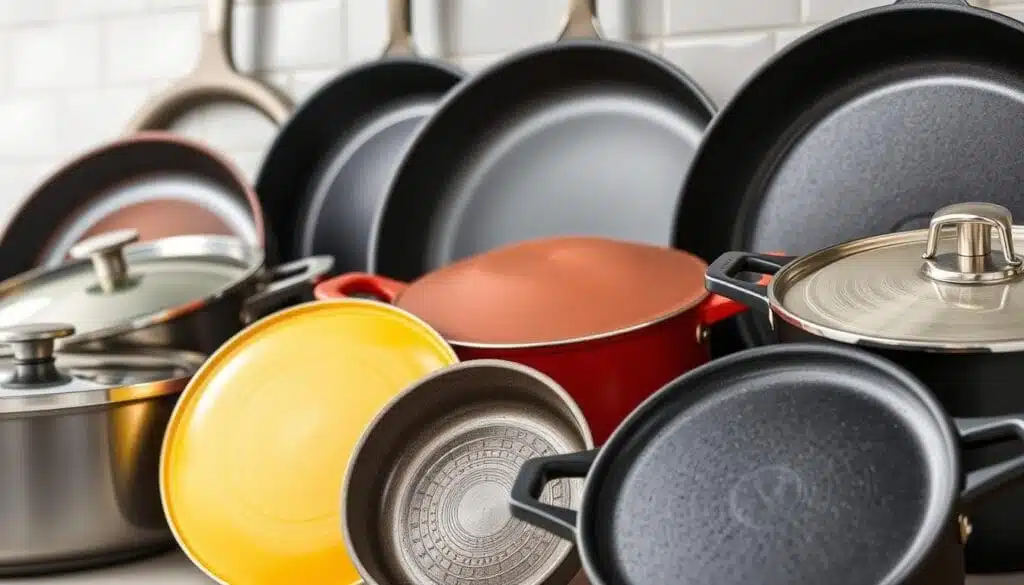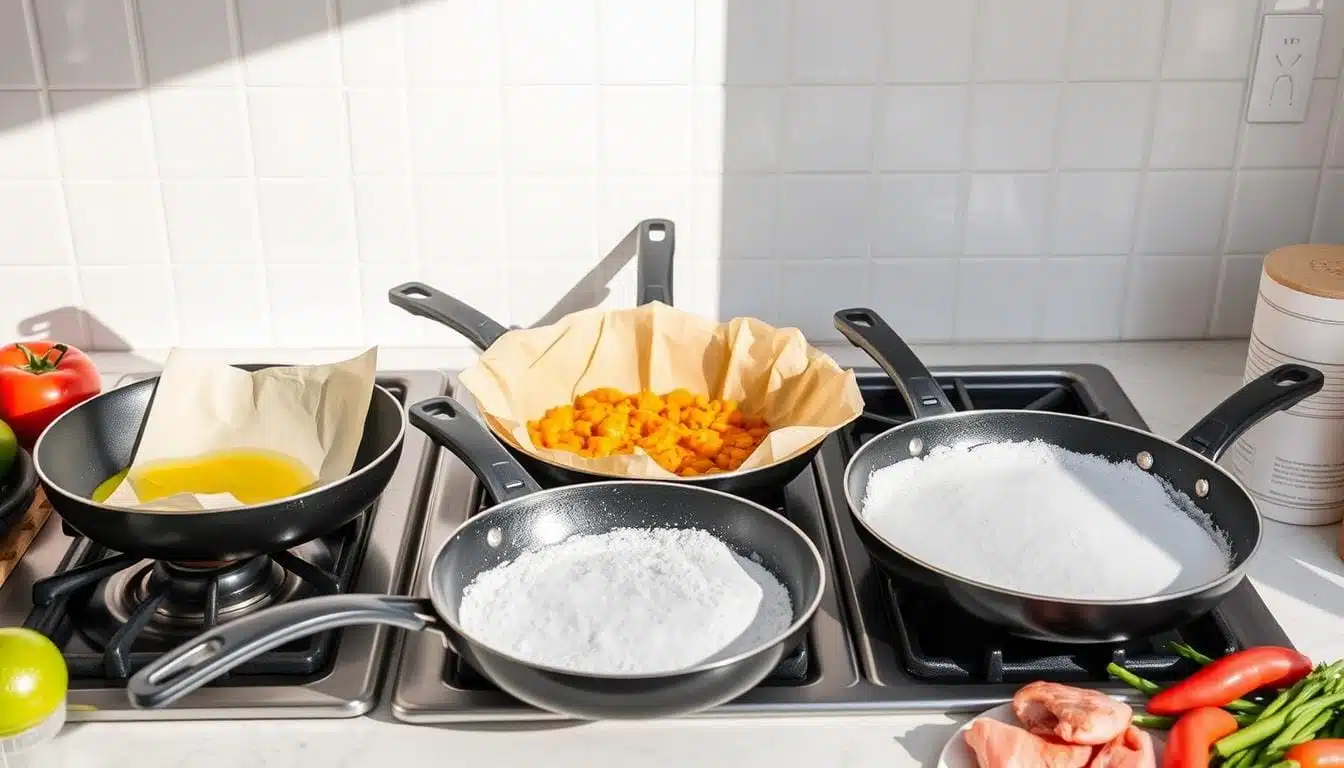Ever found yourself scrubbing a pan, trying to get rid of burnt-on food? It’s a frustrating experience that can ruin the fun of cooking. But, there are simple tricks to avoid sticky, messy pans. In this article, you’ll learn five easy techniques to make cooking and cleaning up a breeze.
As a home chef, I’ve dealt with stubborn cookware. From burnt sauces to stuck meat, it was a constant battle. But, I found 5 tricks to keep food from sticking. Now, I’m excited to share them with you, so you can enjoy stress-free cooking.
Table of Contents
The Importance of Non-Stick Cookware
Non-stick cookware is key in today’s kitchens. It makes cooking easier and more fun. Whether you’re cooking steaks, eggs, or pastries, the right non-stick surface is crucial.
Understanding the Benefits of Non-Stick Pans
Non-stick pans are great because they let food slide off easily. This means less mess and easier cleaning. It’s perfect for foods that stick, like omelets and pancakes.
With a good non-stick surface, food comes off the pan with little effort. It’s a big plus for any cook.
Types of Non-Stick Surfaces and Their Advantages
- PTFE (Teflon): PTFE is the classic non-stick coating. It’s great for food release and easy to clean. But, it needs careful use as it can wear off with high heat.
- Ceramic: Ceramic non-stick surfaces are tough, scratch-resistant, and safe. They release food well and are a top pick for those who care about health.
- Enameled Cast Iron: Enameled cast iron pans have a smooth, glossy surface. They can release food well, thanks to proper seasoning.
Choosing the right non-stick cookware is important. It can greatly improve your cooking experience and make meal prep easier.

5 Tricks to Keep Food from Sticking to Pans
Keeping your cookware non-stick is key for easy food release and cleaning. Whether you’re cooking steaks, frying eggs, or baking pastries, these 5 tricks will help. They ensure your food doesn’t stick to the pan, making cooking a breeze.
- Preheating the Pan: Start by heating your pan slowly over medium heat. This makes the surface even and prevents sticking.
- Oiling the Pan: A thin layer of oil or butter can greatly improve food release. Use a high-heat oil like avocado or grapeseed, just enough to coat the pan.
- Seasoning Cast Iron: Cast iron needs regular seasoning to stay non-stick. Apply a thin layer of oil and bake it to create a protective barrier.
- Avoiding High Heat: High heat can make food stick. Use medium to medium-high heat and adjust as needed to avoid burning or sticking.
- Choosing the Right Utensils: Use silicone, wooden, or nylon utensils to avoid scratching your pans. Metal tools can damage the non-stick coating.
| Trick | Description |
|---|---|
| Preheating the Pan | Allow the pan to heat up gradually over medium heat before adding oil or food |
| Oiling the Pan | Use a high-heat oil or butter to lightly coat the surface of the pan |
| Seasoning Cast Iron | Bake a thin layer of oil onto the surface of cast iron cookware |
| Avoiding High Heat | Use medium to medium-high heat to prevent burning or sticking |
| Choosing the Right Utensils | Use silicone, wooden, or nylon utensils to avoid scratching the non-stick surface |
By using these 5 tricks, you can make cooking easier and more enjoyable. Say goodbye to stuck food and hello to delicious meals every time.

Proper Preheating and Oiling Techniques
Learning how to preheat and oil your cooking surfaces is key to preventing food from sticking. The right methods can greatly improve your cooking experience. They help create a non-stick environment and make food release easy.
The Role of Oil and Butter in Food Release
Oils and butter are essential for food release. They form a barrier between the food and the cooking surface, preventing sticking. But, the type and amount used can affect how well this works.
To get the best results, it’s important to know the best preheating techniques and oiling techniques for your cooking needs. Properly preheating your pan and using the right amount of oil or butter can greatly enhance your cookware’s non-stick performance. This makes cooking easier and more enjoyable.
| Preheating Technique | Oiling Technique | Ideal Oil or Butter Usage |
|---|---|---|
| Heat the pan over medium-high heat for 2-3 minutes before adding any food. | Apply a thin, even coating of oil or melted butter to the cooking surface using a paper towel or pastry brush. | Use just enough oil or butter to lightly coat the surface, avoiding excess which can lead to smoking or uneven cooking. |
By using these preheating techniques and oiling techniques, you’ll become a pro at non-stick cooking. You’ll enjoy perfect food release every time.
Maintaining the Non-Stick Surface
Keeping your cookware non-stick is key for easy food release and cleaning. Whether it’s new or seasoned, regular care is essential. This keeps your surfaces in great shape.
Seasoning Cast Iron Cookware for Better Food Release
Cast iron is known for its heat retention and non-stick qualities. But, it needs some care to stay in top shape. Seasoning your pans creates a smooth, non-stick surface that prevents food from sticking.
- First, clean your cast iron with warm water and a stiff-bristle brush. Avoid soap, as it can remove the seasoning.
- Then, dry the pan well and apply a thin layer of oil like vegetable, canola, or flaxseed.
- Put the pan in a 350°F oven for about an hour. Let it cool completely after.
- Do this a few times to build up a strong, non-stick coating.
Regular use and seasoning will make your cast iron develop a patina. This improves its non-stick qualities, making it a valuable kitchen tool.
| Tip | Benefit |
|---|---|
| Avoid using abrasive cleaners or scouring pads on non-stick surfaces | Preserves the delicate coating and maintains the non-stick performance |
| Store non-stick pans with a paper towel or cloth between them | Prevents the surfaces from scratching or getting damaged |
| Re-season cast iron cookware as needed | Replenishes the natural non-stick properties and prevents rusting |
By following these tips, you can keep your non-stick cookware in great shape. Enjoy easy food release for many years.
“A well-seasoned cast iron pan is a cook’s best friend. It’s virtually non-stick, heats evenly, and can last a lifetime with proper care.”
Oven Temperature Control for Baked Goods
Keeping the oven at the right temperature is key for baking. It prevents your treats from sticking to the pan. The correct temperature ensures even cooking and helps your bakeware stay non-stick. We’ll look at how to control oven temperature for perfect baking.
Preheating your oven is crucial. Recipes often specify a temperature. Not preheating enough can cause sticking.
The type of bakeware matters too. Non-stick pans, like those with silicone or ceramic, help food release. But, they need the right oven temperature to work best.
Keep an eye on the oven temperature while baking. Don’t open the oven door too often. This can mess with the temperature. Also, get an oven thermometer to check your oven’s temperature.
Learning to control oven temperature unlocks your non-stick bakeware’s full potential. With practice, you’ll bake with confidence. Your creations will always come out of the pan easily.
Choosing the Right Utensils
Keeping your non-stick cookware in top shape is key. The right utensils play a big role in this. The wrong tools can scratch and damage your pans.
The Importance of Silicone and Wooden Utensils
Silicone and wooden utensils are best for non-stick surfaces. They are gentle and won’t scratch like metal tools can. Silicone is flexible and heat-resistant, moving smoothly over your pans. Wooden utensils are also a safe choice, as they won’t scrape your cookware.
Using silicone and wooden utensils helps keep your non-stick pans in great shape. This simple choice can extend the life of your cookware. It ensures easy food release and cleaning every time you cook.
“Investing in the right tools for your kitchen can make all the difference in protecting your non-stick cookware and ensuring optimal cooking results.”
| Utensil Type | Advantages for Non-Stick Cookware |
|---|---|
| Silicone Utensils | Soft, flexible material that won’t scratch or damage non-stick surfaces |
| Wooden Utensils | Durable and gentle on non-stick coatings, won’t scrape or mar the surface |
| Metal Utensils | Can easily scratch and damage non-stick surfaces, leading to premature wear and tear |
Cleaning Stuck-On Food from Pans
Dealing with stubborn food residue on your cookware can be frustrating. But, with the right techniques, you can make your pans shine again. Whether it’s baked-on casserole or caramelized sauces, these methods will help you remove tough residue.
Effective Methods for Removing Stubborn Residue
Try these proven cleaning techniques to tackle persistent food buildup:
- Baking Soda Scrub: Mix baking soda and water to make a paste. Use a non-abrasive sponge or scrubbing pad to gently scrub the affected areas. Baking soda’s mildly abrasive nature can help lift and remove stuck-on food.
- Vinegar Soak: Fill the pan with a mix of equal parts white vinegar and water. Let it soak for 30 minutes to an hour. Vinegar’s acidic properties can help dissolve and break down stubborn residue.
- Boiling Water: Boil water in the affected pan and let it simmer for several minutes. The intense heat can help loosen and dislodge caked-on food.
- Bar Keepers Friend: Use this mild abrasive cleaner for tough spots. Apply it with a damp sponge or cloth and let it sit for a few minutes before scrubbing and rinsing.
- Lemon Juice and Salt: Mix lemon juice and salt to create a natural cleaning paste. Use it to scrub the pan. The acidic lemon and abrasive salt can effectively remove stuck-on food and residue.
Always use caution and avoid harsh cleaning methods that could damage your pans. With a bit of effort and the right techniques, you can keep your cookware in great shape and free of stubborn food buildup.
| Cleaning Method | Benefits |
|---|---|
| Baking Soda Scrub | Gently lifts and removes stuck-on food |
| Vinegar Soak | Dissolves and breaks down stubborn residue |
| Boiling Water | Loosens and dislodges caked-on food |
| Bar Keepers Friend | Tackles particular stubborn spots |
| Lemon Juice and Salt | Removes stuck-on food and residue naturally |
“With the right cleaning techniques, you can restore your pans to their former glory, even after dealing with the most stubborn food buildup.”
Common Mistakes to Avoid
When cooking with non-stick pans, it’s key to avoid common mistakes. One big one is using high heat. This can damage the non-stick coating and make food stick. Instead, use medium or low heat to cook your food gently.
Another mistake is using metal utensils on non-stick pans. Metal’s sharp edges can scratch the surface, losing its non-stick quality. Use soft, silicone, or wooden utensils to keep your pans in good shape.
Lastly, not cleaning and maintaining your non-stick pans properly can cause problems. Make sure to clean them as the manufacturer suggests. Avoid using harsh cleaners or abrasive scrubbers that can harm the surface. By avoiding these mistakes, you can enjoy easy and non-stick cooking every time.
FAQ
What are the key tricks to prevent food from sticking to pans?
To prevent food from sticking, follow these 5 essential tricks. First, preheat and oil your pan properly. Keep your cookware in good condition. Control the oven temperature for baked goods. Choose the right utensils. And clean stuck-on food residue effectively.
Why is non-stick cookware important for preventing food from sticking?
Non-stick cookware is key because it makes food release easy. It’s also easy to clean and durable. Different non-stick surfaces, like PTFE, ceramic, and enameled cast iron, offer unique benefits.
How do I properly preheat and oil my pan to prevent sticking?
To prevent sticking, preheat your pan well and use the right oil or butter. Make sure the pan is hot and evenly coated with oil or butter. This will help food slide off easily.
How do I maintain the non-stick surface of my cookware?
To keep your cookware non-stick, season cast iron pans and avoid harsh cleaners. Use the right utensils. Regular care will extend your pans’ life and make food release effortless.
What’s the best way to control oven temperature for baked goods to prevent sticking?
For baked goods, the right oven temperature is crucial. Monitor and adjust the temperature. Use proper baking techniques. This ensures your treats release easily from the pan.
Which utensils should I use to protect my non-stick surfaces?
Use silicone or wooden utensils for non-stick cookware. They won’t scratch the surface. Avoid metal tools, which can damage the non-stick coating over time.
How can I effectively remove stubborn, stuck-on food from my pans?
For stuck-on food, soak the pan in hot water or use a baking soda and vinegar solution. Gently scrub with a non-abrasive sponge or brush. These methods can remove stubborn residue without harming the non-stick surface.
What are some common mistakes to avoid when trying to prevent food from sticking?
Avoid not preheating the pan, using the wrong oil or butter, and cooking at the wrong temperature. Also, don’t use metal utensils that can scratch the surface. Attention to these details ensures the best non-stick results.


2 thoughts on “5 Tricks to Keep Food from Sticking to Pans”
Comments are closed.